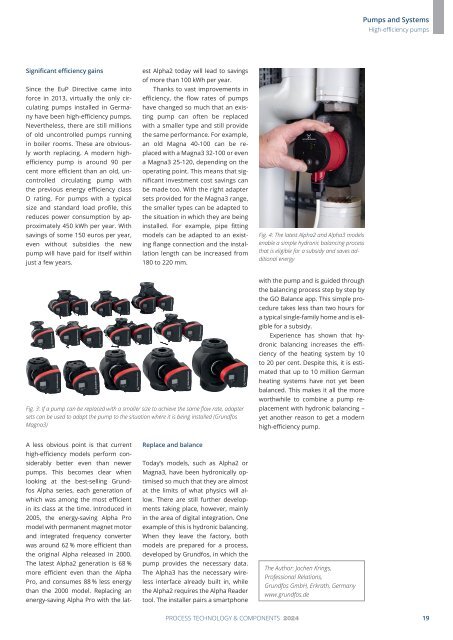PuK - Process Technology & Components 2024
A technical trade magazine with a history of more than 60 years.
A technical trade magazine with a history of more than 60 years.
Create successful ePaper yourself
Turn your PDF publications into a flip-book with our unique Google optimized e-Paper software.
Pumps and Systems<br />
High-efficiency pumps<br />
Significant efficiency gains<br />
Since the EuP Directive came into<br />
force in 2013, virtually the only circulating<br />
pumps installed in Germany<br />
have been high-efficiency pumps.<br />
Nevertheless, there are still millions<br />
of old uncontrolled pumps running<br />
in boiler rooms. These are obviously<br />
worth replacing. A modern highefficiency<br />
pump is around 90 per<br />
cent more efficient than an old, uncontrolled<br />
circulating pump with<br />
the previous energy efficiency class<br />
D rating. For pumps with a typical<br />
size and standard load profile, this<br />
reduces power consumption by approximately<br />
450 kWh per year. With<br />
savings of some 150 euros per year,<br />
even without subsidies the new<br />
pump will have paid for itself within<br />
just a few years.<br />
est Alpha2 today will lead to savings<br />
of more than 100 kWh per year.<br />
Thanks to vast improvements in<br />
efficiency, the flow rates of pumps<br />
have changed so much that an existing<br />
pump can often be replaced<br />
with a smaller type and still provide<br />
the same performance. For example,<br />
an old Magna 40-100 can be replaced<br />
with a Magna3 32-100 or even<br />
a Magna3 25-120, depending on the<br />
operating point. This means that significant<br />
investment cost savings can<br />
be made too. With the right adapter<br />
sets provided for the Magna3 range,<br />
the smaller types can be adapted to<br />
the situation in which they are being<br />
installed. For example, pipe fitting<br />
models can be adapted to an existing<br />
flange connection and the installation<br />
length can be increased from<br />
180 to 220 mm.<br />
Fig. 4: The latest Alpha2 and Alpha3 models<br />
enable a simple hydronic balancing process<br />
that is eligible for a subsidy and saves additional<br />
energy<br />
Fig. 3: If a pump can be replaced with a smaller size to achieve the same flow rate, adapter<br />
sets can be used to adapt the pump to the situation where it is being installed (Grundfos<br />
Magna3)<br />
with the pump and is guided through<br />
the balancing process step by step by<br />
the GO Balance app. This simple procedure<br />
takes less than two hours for<br />
a typical single-family home and is eligible<br />
for a subsidy.<br />
Experience has shown that hydronic<br />
balancing increases the efficiency<br />
of the heating system by 10<br />
to 20 per cent. Despite this, it is estimated<br />
that up to 10 million German<br />
heating systems have not yet been<br />
balanced. This makes it all the more<br />
worthwhile to combine a pump replacement<br />
with hydronic balancing –<br />
yet another reason to get a modern<br />
high-efficiency pump.<br />
A less obvious point is that current<br />
high-efficiency models perform considerably<br />
better even than newer<br />
pumps. This becomes clear when<br />
looking at the best-selling Grundfos<br />
Alpha series, each generation of<br />
which was among the most efficient<br />
in its class at the time. Introduced in<br />
2005, the energy-saving Alpha Pro<br />
model with permanent magnet motor<br />
and integrated frequency converter<br />
was around 62 % more efficient than<br />
the original Alpha released in 2000.<br />
The latest Alpha2 generation is 68 %<br />
more efficient even than the Alpha<br />
Pro, and consumes 88 % less energy<br />
than the 2000 model. Replacing an<br />
energy-saving Alpha Pro with the lat-<br />
Replace and balance<br />
Today’s models, such as Alpha2 or<br />
Magna3, have been hydronically optimised<br />
so much that they are almost<br />
at the limits of what physics will allow.<br />
There are still further developments<br />
taking place, however, mainly<br />
in the area of digital integration. One<br />
example of this is hydronic balancing.<br />
When they leave the factory, both<br />
models are prepared for a process,<br />
developed by Grundfos, in which the<br />
pump provides the necessary data.<br />
The Alpha3 has the necessary wireless<br />
interface already built in, while<br />
the Alpha2 requires the Alpha Reader<br />
tool. The installer pairs a smartphone<br />
The Author: Jochen Krings,<br />
Professional Relations,<br />
Grundfos GmbH, Erkrath, Germany<br />
www.grundfos.de<br />
PROCESS TECHNOLOGY & COMPONENTS <strong>2024</strong><br />
19

















